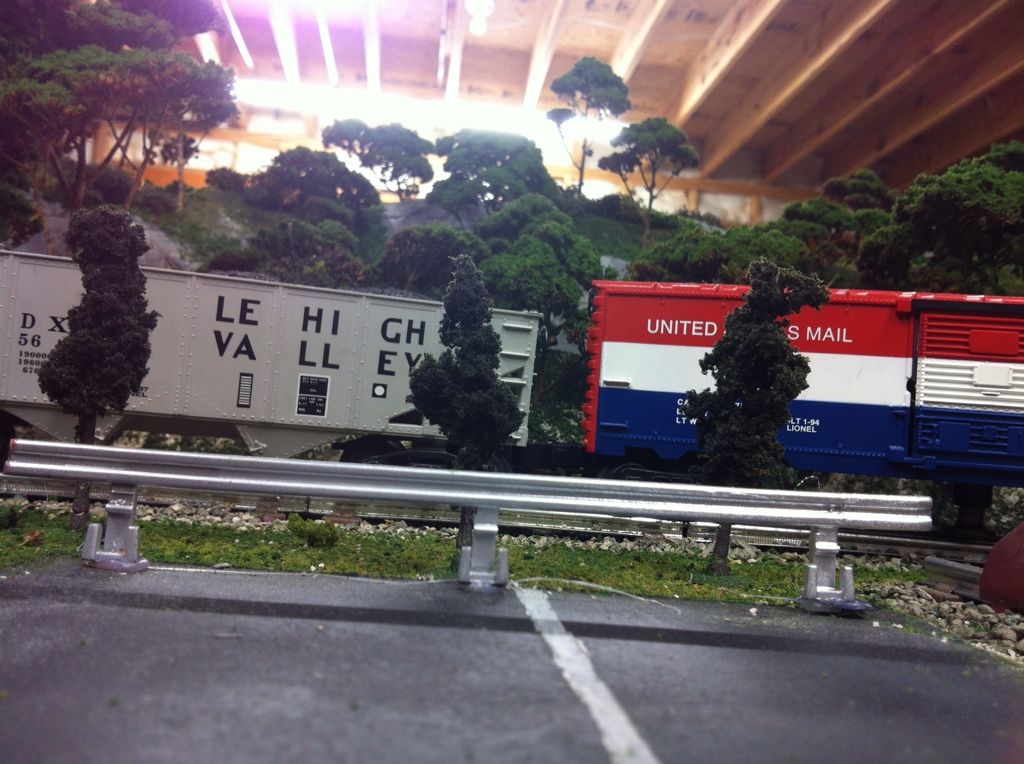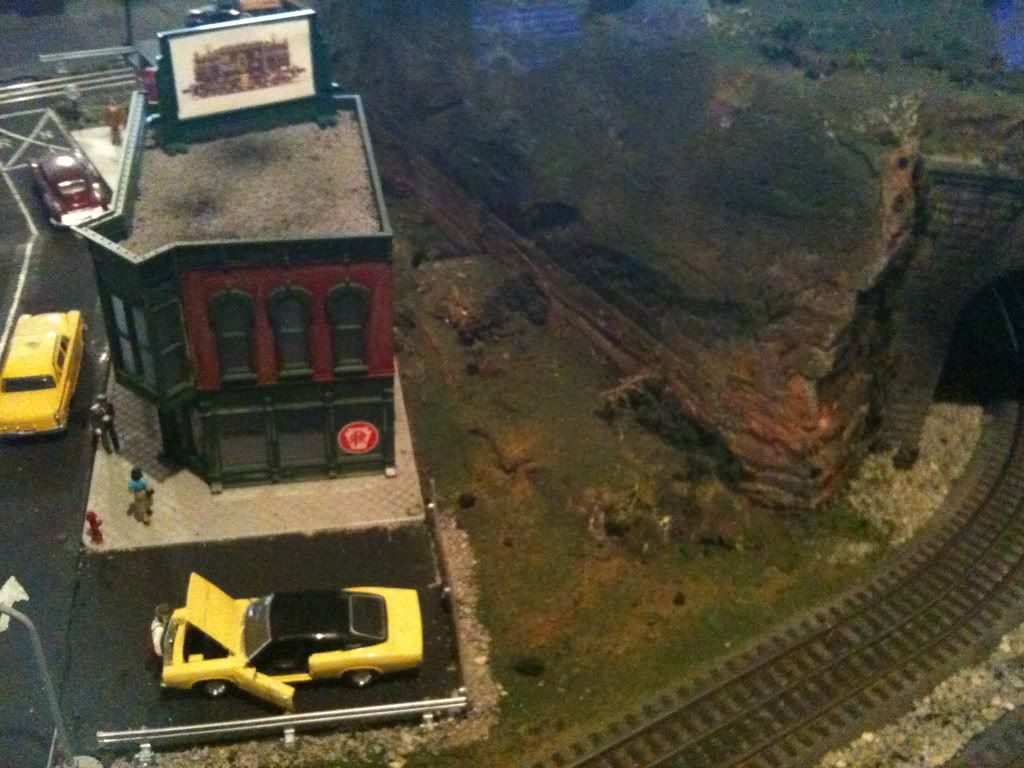I have an area that I want to put guardrail along a street. Has anyone made one? Do you know of a source?
Thanks
doug
|




|
I have an area that I want to put guardrail along a street. Has anyone made one? Do you know of a source?
Thanks
doug
Replies sorted oldest to newest
This may not be what you have in mind, but I was wondering if the guard rails/barriers made for slot-car racing track may be suitable after a bit of modification?
Doug,
When you come over, I will show you my guardrail idea.
Eliot
Hi
K-Line made ones that look great. thay are made to look like steal gard rail.

 Max
MaxThe guard rail on the Lionel easy streets is a nice short piece. I recall that someone on the forum made them a few years ago but I cannot recall who. Maybe Eliot has the answer.
How about using a rail from a straight secton of O gauge track? Probably can figure someway to add the posts.
franktrain
I've used the corrugated type white cardboard that comes in light bulb cartons and pizza box liners. Use fireplace matches for uprights, and paint silver.
TrainsRMe beat me to it. A forum member some years ago had some beauties made out of light bulb package liners. Spray painted them gray and they looked like the real thing.
Another forum member made some for back in the 40s when they used to be black and white wooden posts with cable strung between them. Those looked cool too. I think he used wooden dowels and heavy thread between. I don't know which era you want.
.....
Dennis
Thanks for all of the great ideas.
I suppose a hobby shop would have the slot car railings.
Eliot, we can talk tomorrow.
The K-Line ones would, I assume, be hard to find.
Lionel rail, that's a thought
Corrugated cardboard, I'll check that out.
Doug
Like Harry posted - I used the K-Lionel SuperSteets guardrails which can be bent if the curved ones don't work:
http://store03.prostores.com/s...Streets-10%22/Detail
--Greg
Here's a wooden post with steel cable guardrail as commonly seen in the commonwealth of Pennsylvania from the 1920's into the 50's. Many lasted into the 1970's. I used 1/4" dowel rods, styrene blocks for the standoffs, and HO lift rings for the steel loops holding the cables to the standoff blocks
Hi Neal---what did you use for cable and what size styrene did you use for the blocks?
That looks very realistic!
--Greg
As far as painting those K-Line guards, go to a hobby shop or on-line one that sells radio control cars. Pick up some Pactra Racing Finish in the color you need. This is an acrylic, water based paint that they use on those plastic car bodys and is very flexible. I use it on plastic hand rails. Works great.
Love your guard rail/barrier Neil!!! My Dad tells me stories of working, as a kid, for the state in the 1940's painting the posts. In WV they ran one cable through a hole drilled about 6 inches down from the top. On the curves they sometimes placed a glass bead, about 2 inches in diameter, that glowed with some iridescent material behind it. Dad says they told him they were somewhat radioactive! I plan on modeling these on my layout! BTW....they lasted here into the late 1970's!
You didn't say whether you wanted an auto- or pedestrian-type guard rail. For auto, the examples give earlier are good - I use pieces "two corrugations wide) that I cut from thin corrugated sheet plastic (JTT and Evergreen both make it) for auto guard rails.
The pedestrian guard rails below were made from jumbo paper clips.
Here's a 1950's version using steel I beams painted flat white rather than wooden posts. Posts are then rusted using rust colored chalks. The stuff was ubiquitious in Pennsylvania with lots of it lasting well into the 1990's. You can still see a few sections here and there even today. Cables are made of gray thread. This is shot on a not quite finished part of the layout.
I made them by cutting strips from PlasTruct "corrigated roofing"sheets. Unlike the cardboard material, this can bend for curved road.
Doug after you called i checked our stock we have about 25 boxes 8.99 for set of two.
Here's a 1950's version using steel I beams painted flat white rather than wooden posts. Posts are then rusted using rust colored chalks. The stuff was ubiquitious in Pennsylvania with lots of it lasting well into the 1990's. You can still see a few sections here and there even today. Cables are made of gray thread. This is shot on a not quite finished part of the layout.
Harry,
Where can I get those K-Line guard rails?
Great new scene Neal!
Neil,
Your roads look great. Its that kind of detail that makes scenes realistic.
I remember riding on them in the 50's. When did they add the white line to the outside edges of the lanes? Also, the "no pass" centerline was a single white stripe. I remember everyone standardizing on the "double yellow" center striping and outside edge stripes but can't tell you the year.
Jan
PS. Checked Wikipedia and the US adopted the current scheme in 1971 and completed the changeover by 1975.
Thanks for the nice comments about my scene, which is not completed. I should have pointed out that the guardrails I installed here typical of what was being installed by the PA Dept of Highways in the late 1940's and 50's. The scene as pictured represents the 1960's. In that era, the emphasis was on construction of the interstate highways, and Pennsylvania's secondary roads suffered. By then, the white I beam guard rail posts were well rusted and sticking up at crazy angles due to lack of maintenance. Also note that the 3rd, 4th and 5th posts back on the right are all leaning to the right. This is due to a landslide condition where the fill on which the road sits is slowly sliding down towards the tracks out of view to the right. The pavement in this area is settling as a result of the landslide and is haphazardly patched. The slide is taking the guardrail along with it. The many cracks in the asphalt are sealed using hot tar since funds were insufficient to repave the road as really should have been done.
I can't give you an exact date when the change was made from a single center stripe to a double, but I can say with certainty that it was standard practice in the mid-1960's. The change from white to yellow is properly explained in Jan's post above. I think the use of edge lines was dependant upon funding, how heavily travelled the road was, and local practices.
In Pennsylvania, all this changed when Dick Thornburgh became govenor in 1978. He raised the funds so PennDOT was adequately funded, and turned it from a cesspool of patronage into a professional organization. I should know. I used to work for the local PennDOT office in the summers in that era, and saw the changes first hand. Today, though Pennsylvanians still complain, the roads are in far better shape than the 60's and 70's when some of them had become barely passable.
BTW,
Here's a photo of the prototype scene upon which my scene is based on. The hamlet of Longfellow about 12 miles west of Lewistown, PA. Photos were taken this past August. No guardrail right here, but it is behind the photographer (me!) The road is PA 103:
Access to this requires an OGR Forum Supporting Membership
